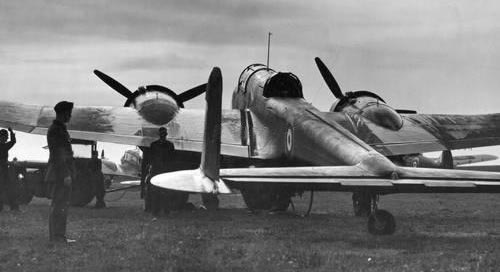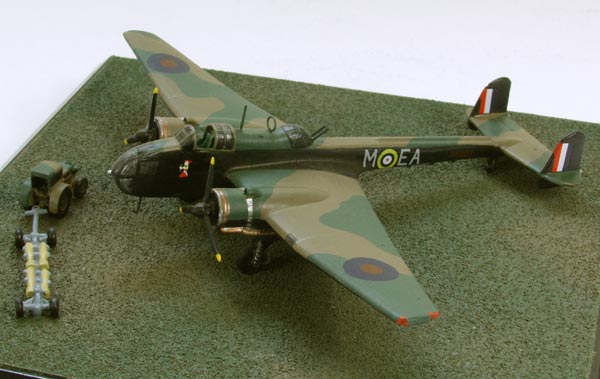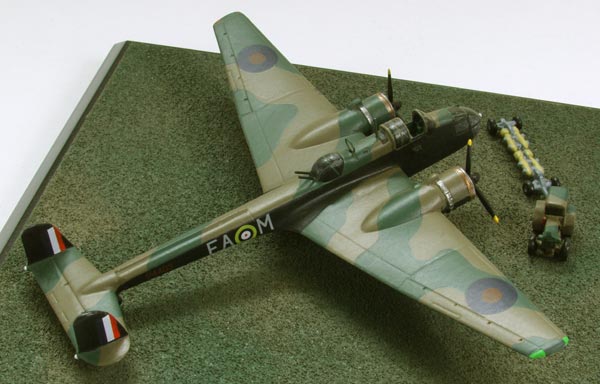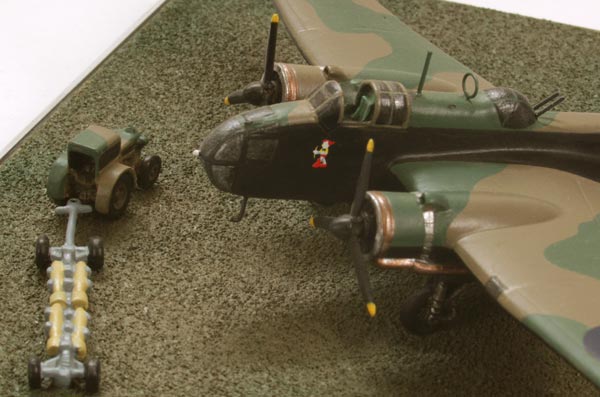Handley Page Hampden Mk I
Handley Page Hampden Mk I P4403 EA-M ‘Pinnochio’
Flt. Lt. R A B ‘Babe’ Learoyd VC, 49 Squadron, August 12th 1940.
On the night of August 12th, 1940, a force of eleven Handley Page Hampden Mk Is from Scampton, six from 49 Squadron and five from 83 Squadron were detailed for a raid on the Dortmund-Ems Canal, the specific target being an aqueduct carrying the canal over the Ems, just north of Munster. The canal had been raided on several previous occasions without great success, and was known to be well-defended by flak guns situated each side of the waterway, thus providing a veritable lane of fire through which any attacker would have to fly. Take-off was set for 20.00hrs with an ETA of 2315hrs, and the Hampdens were loaded with delayed action HE canisters which were to be dropped at precisely two-minute intervals between aircraft to ensure safety for following raiders. Four Hampden MK Is of the force were briefed to act as diversion bombers, raiding other targets in the vicinity, and in the event two other Hampdens failed to locate the primary target and bombed Texel Island instead. The remaining five Hampden Mk Is arrived over the canal slightly ahead of ETA, Flt Lt R A B Learoyd, piloting P4403, EA-M was to be the last to bomb and circled the area for the next ten minutes.
The first to bomb was P4402 of 83 Squadron, piloted by Flight Lieutenant ‘Jamie’ Pitcairn-Hill, DFC, who swept in at just over a 100ft height and received the first attention of the flak guns. Releasing his bomb load, Pitcairn-Hill banked swiftly out of the flak zone and limped home, his aircraft badly damaged by dozens of flak strikes. The second Hampden, P4410 piloted by the Australian, Pilot Officer Ross, received a direct hit on his run-in and crashed in flames alongside the canal. Third to run the gauntlet of shellfire was another Australian from 83 Squadron, Flying Officer A. R. Mulligan, DFC in Hampden P4340. As he plunged through the curtain of tracers and shells his port engine was hit and exploded into flames. Jettisoning his bomb load quickly, Mulligan climbed swiftly to 2,000ft and then ordered his crew to bale out. As the last man left the stricken bomber, Mulligan followed and saw his aircraft dive into the ground and explode. All four crew members survived and were taken prisoner. Fourth in line came Pilot Officer Matthews who bombed successfully and then struggled back to base with only one good engine. It was now Learoyd’s turn. Flattening out at 150feet height, some three miles north of the objective, Learoyd flew straight and level along the canal approach into the teeth of an inferno of flak and blinding searchlights. His Hampden was hit repeatedly, with chunks of the starboard wing being punched out; while the intensity of glare from the searchlights forced Learoyd to keep his head down and fly solely on instruments, relying on his bomb aimer/navigator Pilot Officer John Lewis, to give him the signal to release his bomb load. The signal came at 2323hrs and Learoyd immediately jettisoned the whole load and turned out of the fire zone. Once clear of immediate danger ‘Babe’ took inventory of the flak damage to his Hampden. Most serious was a ruptured hydraulic system, which leaked fluid everywhere, resulting in drooping flaps and a useless undercarriage indicator. Nursing the shattered bomber carefully, Learoyd finally arrived over Scampton in the pre-dawn blackness of the early morning. Rather than risk any further injury to his crew in view of his lack of hydraulic pressure for the undercarriage and flaps, he continued to circle the aerodrome vicinity until first light. He then set the damaged aircraft down smoothly at Scampton and ‘arrived’ safely. Intelligence reports later confirmed that the target had been destroyed, and ‘Jamie’ Pitcairn-Hill, the force leader was awarded a DSO; while Mulligan, then a prisoner of war, was given a Bar to his DFC. On August 20th, 1940 the London Gazette announced the award of a Victoria Cross to ‘Babe’ Learoyd, and part of the citation read, ‘. . . had repeatedly shown the highest conception of his duty and complete indifference to personal danger in making attacks at the lowest altitudes regardless of opposition.’

Scale 1:144 Wingspan 5.76″ (146 mm)
Base size 6.37″ (162 mm) square (No. 4)
Weight not including base 5 ozs (137 grams) Limited edition of 100 only




